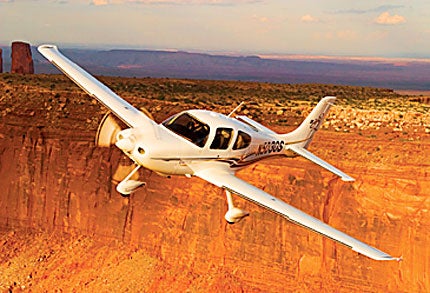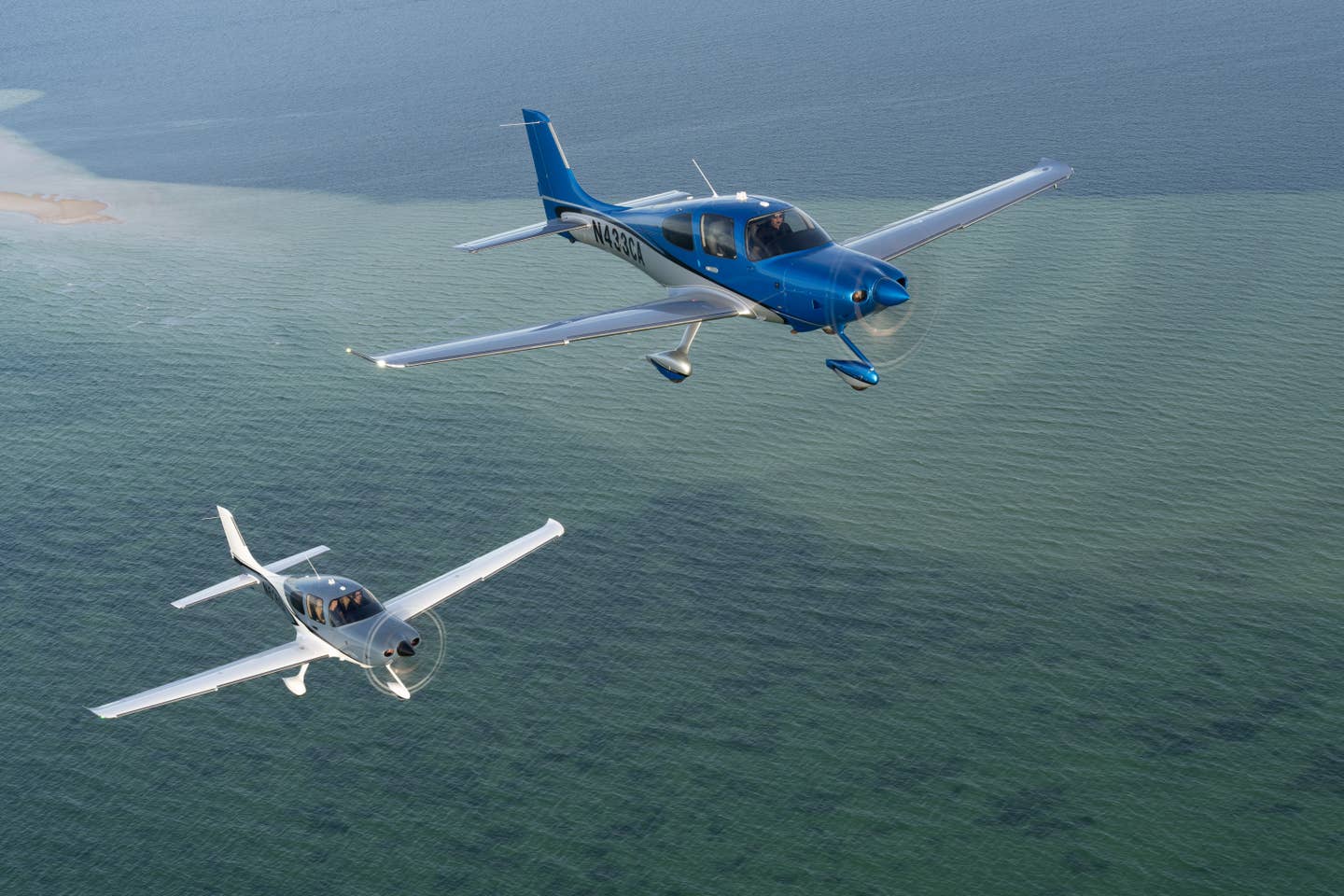Cirrus SR22-G2
The Klapmeiers’ vision enters the second generation
 For those of you who haven't heard, Cessna was just recently dethroned as one of the top-selling general-aviation companies in the world. For the first two quarters of this year, the total number of Cessna Skyhawks and Skylanes was bested by Cirrus Design's combination of SR20 as well as SR22 sales. In fact, the vast majority of Cirrus' sales came from its showpiece, the new SR22-G2. That's all the more amazing when you consider that: a) the SR22 sells for nearly twice the price of a typical Skyhawk; b) the Cirrus model has only been on the market for three years; and c) no other manufacturer has ever succeeded in humbling Cessna in this way.
For those of you who haven't heard, Cessna was just recently dethroned as one of the top-selling general-aviation companies in the world. For the first two quarters of this year, the total number of Cessna Skyhawks and Skylanes was bested by Cirrus Design's combination of SR20 as well as SR22 sales. In fact, the vast majority of Cirrus' sales came from its showpiece, the new SR22-G2. That's all the more amazing when you consider that: a) the SR22 sells for nearly twice the price of a typical Skyhawk; b) the Cirrus model has only been on the market for three years; and c) no other manufacturer has ever succeeded in humbling Cessna in this way.
No other airplane in the history of general aviation has enjoyed so much instant popularity as the Cirrus SR22. When I reviewed and evaluated the experimental prototype Cirrus SR20 in the December 1996 issue under the title "Skyhawk For The 21st Century," I could hardly have imagined that the title would be so prophetic.
The obvious question when any relatively new model of light aircraft becomes such a runaway success is---why? Anyone who has followed the fortunes of brothers Dale and Alan Klapmeier is aware that Cirrus Design was little more than a blip on general aviation's radar screen as recently as 10 years ago.
Technically, both the Klapmeiers were in the homebuilt-design business in the late 1980s and early 1990s, but they had a dream to create a new type of certified, production airplane, a model that would offer superior comfort, performance, simplicity as well as reliability on a modern, 21st-century platform, yet would address the most pressing safety concerns of pilots.
Both Dale and Alan Klapmeier designed homebuilt aircraft for starters, and some of those were indeed sophisticated machines. The VK-30, co-designed by the Klapmeiers and aerodynamicist Jeff Viken, was an unusual pusher single with the engine mounted at mid-cabin and a long drive-shaft turning a single propeller behind the tail. The later ST-50 was a corporate single, powered by a turboprop P&W PT6A in the spirit of the TBM-700. Both of these designs were technically homebuilts, but they certainly dispelled any images pilots might have had that homebuilt equated to amateur. Remember, professionals built the Titanic. Amateurs built the Ark.
Although almost all of their homebuilt concepts have been anything else but traditional, the Klapmeiers recognized that a production airplane needed to at least look conventional, with the tail in the back of the plane and the propeller out front. Accordingly, the two brothers concentrated on creating an airplane that would incorporate its design innovations in a recognizable package at an entry-level price. The hope was to attract new pilots as well as existing aviators.
The Klapmeiers knew that there were practical considerations of starting off with a relatively low-powered engine. "We were looking for the largest possible market and the lowest certification cost," says Dale. "And that inclined us toward the less expensive, more economical-to-operate 200-hp engine. As it turned out, certification probably would have cost roughly the same at any horsepower level, but we didn't end up realizing that until later."
The SR20 was the end result of the Klapmeiers' initial effort. First flown in March 1995, it used a six-cylinder, 200-hp Continental IO-360 for power. It took three years and roughly $70 million for the airplane to be certified, but the SR20 was finally ceremonially granted its FAA type certificate during the 1998 AOPA Convention in Palm Springs, Calif.
The Cirrus SR20 was constructed around a cabin that's specifically modeled after the BMW 5 series sedans, and the airplane represented new concepts in several key areas. There was no cost-effective way to put a BMW cabin in the air, but the SR20's cockpit was nevertheless as spacious and comfortable as possible, copying the German luxury sport-sedan wherever possible.
Specifically, front-seat room measured 49 inches wide by 50 inches high, and rear space was 44 inches wide by 49 inches high, unprecedented at the time for a single-engine airplane. The Cirrus SR20 also employed side-stick controls for roll and pitch, freeing up the space in front of the pilot and copilot and, more than coincidentally, enhancing crashworthiness.
Perhaps equally important, the SR20 offered new solutions in other areas. As mentioned above, the Klapmeiers hoped to attract both new pilots and experienced aviators, and to that end, the SR20 addressed perhaps the two greatest concerns of the flying and non-flying public: "What do I do if the engine quits?" and "What if I get lost?"
The Klapmeiers' answer to the first question was to hide a ballistic parachute inside the upper aft fuselage and employ CEAT (Cirrus Energy Absorbing Technology) by installing crush zones in the floor along with 26 G seats and build a tough roll cage around the cabin. With a descent rate of 26 fps (1,560 fpm), the 2,400-square-foot ’chute was designed to protect the occupants, not the airframe. Actual deployments, however, have resulted in minimum airframe damage.
To help counter the possibility of becoming lost, Cirrus adopted a huge, 10.4-inch, GPS-based Avidyne multi-function display (since expanded to a two-screen primary flight display/multi-function display) that depicted the airplane's position with reference to nearby airports and navaids. This made it virtually impossible for anyone to lose positional awareness and quelled many of the fears of wanna-be pilots, an important segment of Cirrus' planned customer base.
The SR20 met with immediate success, and we all knew that it was only a matter of time before Cirrus introduced an upgraded model. Everyone speculated that a retractable might be the first improved airplane, but that wasn't to be, and for some good reasons. The late Roy LoPresti, speed guru and expert on certification of both fixed and retractable-gear aircraft, explained the logic several years ago: "A retractable doesn't always make sense if you already have an efficient fixed-gear design. The retraction mechanism is always heavier and more complex and adds quite a bit to production incorporation costs, and the drag reduction may not be that great. You'll often realize only an extra 10 to 12 knots more speed, sometimes 15 knots. Certification costs are higher, as well, and of course, a retraction system is just one more system that can fail."
For all of those reasons, both the Klapmeiers elected to concentrate instead on a horsepower makeover. The Cirrus SR22 was a logical next step, a 310-hp Continental IO-550N-powered version of the original design. The fuselage was the same, although the nose was pushed forward to accommodate the larger engine. Wingspan was increased 1.5 feet per side, adding 10 square feet of surface area, the better to lift 3,400 pounds of gross, 400 pounds more than the SR20. The SR22 also was an all-electric airplane, without a vacuum system.
The performance benefits of adding 55% more horsepower were immediate and predictable. Climb performance, always the primary beneficiary of any power increase, improved by 500 fpm to 1,400 fpm at sea level. Cruise jumped 20 knots, from 160 to 180 knots, vaulting the SR22 up into the Mooney speed class.
Useful load went up 220 pounds to 1,150 pounds, although some of that was lost to the higher fuel capacity, 81 gallons versus 56 gallons on the SR20. The SR22 almost immediately began outselling the SR20, causing 20% of existing SR20 customers to upgrade their orders to the more powerful airplane. By 2003, the new model was accounting for 80% of the Duluth, Minn., company's sales in dollars.
Now comes the Cirrus SR22-G2. In this case, "G2" doesn't allude to an exotic, long-range business jet, but stands for "second generation---because evolution shouldn't take 50 years," according to Cirrus. We can all agree on that. The SR22 utilizes the SIMPLE (Single Movement Power Lever) power system, a total integration of throttle and propeller control that allows the pilot to manage both parameters with a single lever.
The G2 incorporates a number of new features, refinements to the SR22 design that serve to enhance function and comfort. Cirrus paid attention to such things as door latches. General-aviation door latches have often been regarded as clumsy and inefficient, too often making doors difficult to latch and thereby increasing the likelihood that they'll pop open in flight. The new Cirrus door-latching system is automotive in concept, providing easier closing and opening with the push of a single button. Cirrus calls the new system Secure Latch, and it even extends to the baggage compartment.
Engine mounts might not seem a logical target for improvement, but a solid engine mount can make the difference between a smooth engine and one that will send vibrations through the airframe and passengers. The G2 adopts a six-point mounting system, compared to four points on most general-aviation designs. The additional two isolators help secure the engine to the mount and avoid much of the fatigue associated with vibration.
In a similar sense, propeller design and mating to the airframe has a major impact on performance and smoothness. On the second-generation SR22, Cirrus utilizes a semi-scimitar---called Scimitar Select---three-blade prop that provides maximum airflow at the roots for better engine cooling and improved design at the tips for reduced noise and drag.
Proper cowling design is critical to minimize drag and flow a large volume of air through the engine enclosure for cooling. The G2's cowling has been reengineered to refine the shape and reduce the size of the exhaust contours. While they were at it, Cirrus reconfigured the lower cowling to two pieces, redesigning it for easier removal and replacement and better access to the bottom of the engine.
Cirrus' engineers also improved service access to the inboard wing spar-to-fuselage join area, the empennage as well as the Cirrus Airframe Parachute System (CAPS). The intent was to make the Cirrus SR22-G2 a more convenient airplane rather than try to enhance the Cirrus SR22's already good performance.
Throw in the magnificently upgraded interior, and the new SR22-G2 offers an attractive, comfortable, high-tech package of talents capable of transporting four folks across far horizons at good speed. The 81-gallon fuel tanks allow pilots to reach out and touch a destination nearly 750 nm away, provided that they're willing to sit in the seat for 4.5 hours.
There is a price to be paid for all this innovation and talent. Specifically, as the top of the Cirrus line, the G2 sells for a base $334,700. As a head-to-head competitor with the Lancair Columbia 350 and Mooney Ovation2 DX, the Cirrus SR22-G2 combines the best of the new technology with performance and comfort that any pilot can appreciate.
For more information about the Cirrus SR22-G2, contact Cirrus Design Corporation at (218) 727-2737 or log on to www.cirrusdesign.com.
SPECS: 2004 Cirrus SR22-G2

Subscribe to Our Newsletter
Get the latest Plane & Pilot Magazine stories delivered directly to your inbox






